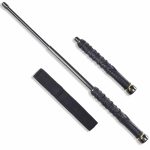Introduction

Personal safety and preparedness are paramount in today’s unpredictable world. Whether it’s walking alone at night or facing a potential threat, being equipped with the necessary tools and knowledge can make a significant difference. In this article, we will explore the importance of personal safety and discuss the significance of self-defense kits in empowering individuals to protect themselves.
I. Importance of Personal Safety and Preparedness
Maintaining personal safety is crucial for leading a secure and confident life. Understanding and acknowledging potential threats are the first steps towards establishing a safer environment for yourself. By taking proactive measures for personal safety, such as acquiring self-defense skills and tools, individuals can enhance their overall well-being and peace of mind.
II. Understanding Self-Defense Kits
A. Definition and Purpose of a Self-Defense Kit
A self-defense kit is a collection of tools designed to assist individuals in protecting themselves during potential emergencies or threatening situations. These kits are specifically curated to provide individuals with a sense of empowerment and a means to defend themselves. The purpose of a self-defense kit is to build confidence, promote personal safety, and provide immediate assistance when faced with an unforeseen danger.
B. Components of a Typical Self-Defense Kit

- Personal Alarms and Whistles
Personal alarms and whistles are important components of self-defense kits. These compact and easily accessible tools emit a loud sound that can deter attackers or draw attention to the situation. By activating a personal alarm or blowing a whistle, individuals can alert nearby individuals and potentially scare off an assailant.
- Pepper Spray or Stun Gun
Pepper spray and stun guns are non-lethal defensive tools commonly included in self-defense kits. Pepper spray, a chemical compound that temporarily incapacitates attackers by causing temporary blindness and respiratory distress, can provide a valuable time window for escape. Similarly, stun guns deliver an electric shock, temporarily immobilizing an assailant and allowing the victim to leave the dangerous situation.
- Tactical Flashlight
A tactical flashlight is an essential tool that combines the functions of a durable flashlight and a defensive weapon. These flashlights are often designed with high lumens and strobe functions, capable of disorienting attackers and providing visibility in low-light situations.
- Emergency Mobile Phone Charger
In today’s digitally connected world, having a reliable means of communication is vital during emergencies. Including an emergency mobile phone charger in a self-defense kit ensures that individuals have access to communication in critical situations, even when their phone’s battery is drained.
- First Aid Supplies
Including a basic first aid kit in a self-defense kit can be invaluable for treating minor injuries sustained during an altercation. Bandages, disinfectants, and other essential medical supplies enable individuals to tend to themselves or others until professional medical help is available.
C. How Self-Defense Kits Empower Individuals
Self-defense kits empower individuals by providing them with the means and confidence to protect themselves. By having these essential tools readily available, individuals can react swiftly and effectively during unexpected dangerous situations, potentially minimizing harm. Additionally, owning a self-defense kit promotes a sense of self-assurance, allowing individuals to venture out into the world with a heightened sense of personal security.
III. Selecting the Right Self-Defense Kit
A. Assessing Personal Needs and Preferences
- Reflecting on Potential Threats in Your Environment
Consider the specific risks and potential threats that you may encounter in your daily environment. This may include crime rates, personal experiences, or specific vulnerabilities. Assessing these factors will help determine which tools and self-defense techniques are most suitable for your needs.
- Considering Legal Regulations Regarding Self-Defense Tools
Research local laws and regulations regarding the possession and use of self-defense tools. It is essential to understand what is legally permissible in your area to ensure compliance and avoid any legal issues.
B. Researching and Comparing Available Options
- Evaluating Reliability and Effectiveness of Different Tools
Thoroughly research the reliability and effectiveness of various self-defense tools available in the market. Read reviews, watch demonstrations, and consider real-life testimonials to gauge their efficacy in combating potential threats.
- Looking for Reputable Brands and Certifications
Opt for self-defense kits that are manufactured by reputable brands and have undergone certifications or testing for quality assurance. This ensures that the tools included in the kit are of high quality and designed for optimal performance.
C. Seeking Professional Advice and Guidance

- Consulting Self-Defense Experts or Trainers
Consider consulting self-defense experts or trainers to gain valuable insights into effective self-defense strategies and the most suitable tools for your personal circumstances. Their expertise will help you make informed decisions and choose the most appropriate self-defense kit.
- Reaching Out to Local Law Enforcement Agencies
Local law enforcement agencies often provide guidance and resources relating to personal safety. Contact your local authorities to inquire about recommended self-defense tools and techniques specific to your area.
IV. Educational Resources and Training
A. Importance of Proper Training and Education
- Developing Physical and Mental Preparedness
Proper training and education in self-defense not only teach individuals practical techniques but also improve physical fitness and mental preparedness. Training helps individuals develop strength, coordination, and the ability to remain calm under pressure.
- Improving Situational Awareness and Response
Training in self-defense enhances situational awareness, enabling individuals to recognize potential threats and react appropriately. Learning how to assess potential risks and develop effective responses can significantly increase personal safety.
B. Seeking Self-Defense Courses or Workshops
- Learning Basic Techniques for Personal Safety
Enrolling in self-defense courses or workshops provides individuals with the opportunity to learn basic techniques for personal safety, such as situational awareness, effective striking, and defensive maneuvers. These courses teach individuals how to use their bodies as weapons, maximizing their ability to defend themselves.
- Practicing Effective Use of Self-Defense Tools
Some self-defense courses also include training on the proper use of self-defense tools. This instruction ensures that individuals are familiar with the tools in their self-defense kit and know how to use them effectively in real-life situations.
C. Utilizing Online Resources and Tutorials
- Accessing Educational Videos and Guides
The internet offers a wealth of resources in the form of educational videos and guides on self-defense techniques and the proper use of self-defense tools. Online platforms provide step-by-step tutorials, demonstrations, and valuable insights from self-defense experts that can be accessed from the comfort of your own home.
- Finding Virtual Communities or Forums for Support and Advice
Joining virtual communities or forums focused on personal safety and self-defense can provide individuals with a supportive network and a platform to share experiences and seek advice. Engaging with like-minded individuals can enhance knowledge and foster personal growth in self-defense practices.
V. Best Practices for Self-Defense Kit Usage
A. Familiarizing Oneself with Each Tool in the Kit
It is essential to become familiar with the operation and functionality of each tool in your self-defense kit. Regularly review the instructions, practice handling the tools, and understand their limitations to ensure effective use when needed.
B. Regularly Maintaining and Updating the Contents of the Kit
Periodically review and update the contents of your self-defense kit to ensure that all tools and supplies are in good working condition. Replace expired or damaged items, recharge batteries, and perform regular maintenance checks to ensure the tools are ready for use at any given time.
C. Understanding Legal Implications and Appropriate Use of Each Tool
Before carrying any self-defense tool, it is crucial to understand the legal implications and appropriate use in your jurisdiction. Familiarize yourself with local laws regarding possession and use to avoid potential legal consequences. Self-defense tools should only be used in situations of legitimate self-defense to protect oneself or others from imminent harm.

